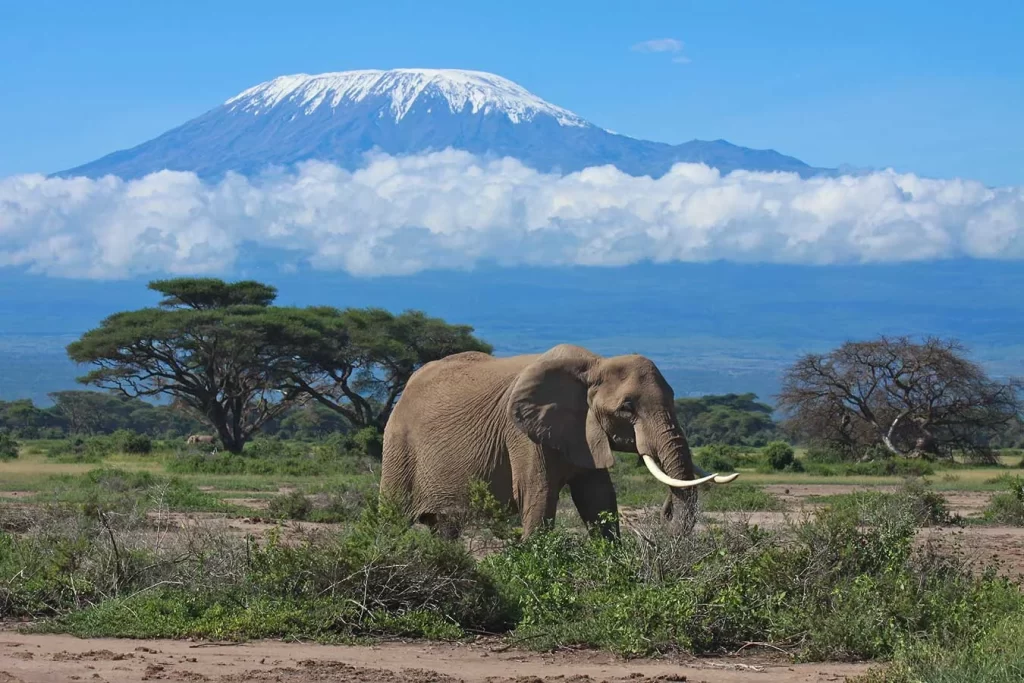Self Drive Guide to Kilimanjaro National Park, Tanzania
Kilimanjaro National Park, the Most Unique in Africa: While organizing a global excursion, there exists a remarkable place where you can indulge in virtually all your desired activities. This remarkable location is Tanzania. Indeed, it is the location of three of the Seven Natural Wonders of Africa: the Great Migration, Ngorongoro Crater, and Mount Kilimanjaro. This exquisite country encompasses many cultural groups, national parks, and wildlife reserves that attract thousands of visitors from around the globe. Given Tanzania’s numerous offerings, specialization is essential while selecting activities in this remarkable country. I will now elucidate all pertinent information on Kilimanjaro National Park.
Five Premier Activities in Tanzania
Kilimanjaro National Park is a remarkable protected area situated in the Northern Circuit of northern Tanzania, within the Kilimanjaro region. It encompasses Africa’s highest summit, the globe’s tallest freestanding mountain, and is classified among the Seven Summits. This park encompasses over 1688 square kilometers and is situated near the town of Moshi, 128 kilometers from Arusha. This remarkable park is conveniently accessible from key areas with international airports.
These comprise Dar es Salaam and Arusha. Julius Nyerere International Airport (DAR) accommodates aircraft from multiple countries across various continents, similar to Kilimanjaro International Airport (JRO). Upon arriving in Dar es Salaam, you will need to reserve an additional flight to Arusha. From Arusha, you will proceed to Moshi and subsequently to one of the entrances of Kilimanjaro National Park. Chartered flights from several places in Tanzania are accessible to this park. Regional airlines in Tanzania provide economical flights to Arusha (JRO) and Moshi. Airlines providing domestic flights encompass Air Tanzania, Wings of Kilimanjaro, Coastal Aviation, Precision Air, Fastjet, Auric Air, Flightlink, among others. The optimal periods for visiting Kilimanjaro National Park are from January to March and from June to October. During this period, the sky is unobstructed, enabling clear vistas of this magnificent peak.
Kilimanjaro National Park has numerous things that may captivate your interest. It include Mount Kilimanjaro, diverse wildlife, avifauna, and remarkable flora. Let us examine each item sequentially.
Mount Kilimanjaro is a dormant volcanic peak with three volcanic cones: Kibo, Mawenzi, and Shira. Kibo maintains its snow cover throughout the season, which is why Mount Kilimanjaro is occasionally referred to as the snow-capped mountain. Uhuru Peak, the highest summit, is situated on Kibo. Uhuru Peak is situated at an elevation of 5,895 meters above sea level and approximately 4,900 meters above the plateau base. Climbers must reserve a six to nine-day expedition to attain the top. If you are unaccustomed to high elevations, I recommend undertaking an acclimatization exercise on Mount Meru, the lesser-known counterpart of Mount Kilimanjaro. The Mount Meru walk requires 3 to 4 days to ascend to Social Peak (4566m), allowing for acclimatization to high elevations. Upon acclimatization, you may advance to the magnificent Mt. Meru’s “big brother,” where you will experience the ascent of Africa’s tallest mountain. The ascent of Kilimanjaro is extraordinary.
You must select your optimal operator and the most advantageous route for your ascent. Seven ways are attributed to the peak of the majestic mountain. The routes include Machame, Rongai, Umbwe, Lemosho, Marangu, Northern Circuit, and Shira. The selection of your routes should take into account the difficulty of the summit night. The Machame and Lemosho routes offer relatively simple summit nights, whilst the Rongai and Marangu climbs present the most challenging summit nights. The most isolated path is Rongai, where you will ascend either alone or with a small number of individuals who seldom opt for it. This path provides wonderful sights and comfort. The Machame and Lemosho paths are optimal for acclimatization. Your decision should also account for the duration required to attain the summit. The Umbwe route requires approximately 6 days; the Machame route necessitates 7 days, the Lemosho route extends to 8 days, and the Northern Circuit route spans about 9 days. All these routes vary in price range from one another. For example, Machame is priced at approximately $2540, Rongai at $2630, Lemosho at $2670, Northern Circuit at $2999, Lemosho at $2590, and Marangu at $2450. It is important to recognize that tour operators provide distinctive packages that may appeal to you. Some of the offerings include
A 9-day safari and hike on Kilimanjaro’s Shira Plateau, priced at $3,450 per individual.
9-day trekking expedition on Mount Kilimanjaro via the Lemosho Route at a cost of $2,495 per person.
7-day Kilimanjaro trekking expedition via the Machame route at a cost of $1,945 per individual.
6-day Mount Kilimanjaro trek via Marangu at a cost of $1,500 per person.
Six-day Kilimanjaro ascent via the Umbwe Route at a cost of 1,590 per person. The vegetation zones of Kilimanjaro National Park encompass mountainous flora, extending from the base to the summit. There are five primary vegetation zones: Lowest Zone, Montane Forest Zone, Semi-Alpine Moorland Zone, Alpine Zone, and Arctic Zone.
Lowest Zone, sometimes referred to as Cultivation Zone. It ranges between altitudes of 792 meters and 1800 meters. This area encompasses several human activities, including agriculture and animal grazing. You will appreciate the stunning vistas of this area during your journey to the entrances of Kilimanjaro National Park (Mweka, Marangu, and Machame Gates).
The Montane Forest Zone commences at a height of 1800 meters and extends to 3000 meters. It has significant precipitation, receiving up to 2000mm of rainfall annually. It has more than 1,200 species of vascular plants. The predominant tree species in this region include Yellowwood (Podocarpus latifolius), East African camphorwood (Ocotea usambarensis), wild olive (Olea africana), maracanga (Macaranga kilimandscharica), and wild figs (Ficus sp). At elevated heights, one will observe exquisite plants such as the aromatic Hagenia abyssinica and the African pencil-cedar, Juniperus procera. This area is also adorned with remarkable flowers such as red-and-yellow impatiens and violets. If you wish to engage with the animal species inhabiting this park, this is the optimal area for you. Remarkable sightings of monkeys, Cape buffalos, elephants, leopards, servals, bushbucks, and duikers have been observed here. Remarkable avian species such as Hartlaub’s turaco, silvery-cheeked hornbill, greenbuls, robin-chats, emerald cuckoo, and nectarivorous sunbirds have been observed in this area. Additional fauna species including Jackson’s three-horned chameleon and many butterflies. Are you familiar with the largest duiker species, Abbott’s duiker? This rare species inhabits the highland forests of eastern Tanzania. This zone also contains it.

Semi-Alpine Moorland Zone; located at altitudes of 3000m to 4000m, this zone is sparsely populated with shrubs, grasses, and little trees. It experiences comparatively less precipitation in relation to the montane forest zone. It houses unique flora such as the yellow-flowered alpine sugarbush and the alpine red-hot poker. It is characterized by the prevalence of huge lobelia and giant groundsel. This region’s elevated altitudes allow for the observation of animal species such as mice, rock hyrax, and klipspringers. The avian species thriving at elevated altitudes include the scarlet-tufted malachite sunbird, Augur buzzard, Alpine chat, Alpine swift, streaky seedeater, and Mountain buzzard.
Alpine Zone; this region exists at altitudes ranging from 4000m to 5000m. It is a semi-desert characterized by daily temperature swings. The plant species present in this location include grasses, lichens, and mosses. This zone lacks permanent wildlife. Nevertheless, elands and elephants can occasionally be observed in unusual instances.
The Arctic Zone is the highest vegetation zone in Kilimanjaro National Park. It is situated at altitudes ranging from 5000m to 5895m. This zone has no precipitation. Life is absent in such location. Nonetheless, a frozen leopard was found in 1926, and a group of African wild dogs was identified in 1962.
Upon examining the attractions within this magnificent national park, you may find yourself faced with a quandary regarding activities beyond ascending this formidable mountain. Activities available in the area encompass birdwatching, wildlife observation, primate trekking, and excursions to Lake Chala. This park has more than 150 avian species, rendering it a remarkable locale for ornithologists. Birdwatchers will appreciate observing mountain birds and species inhabiting elevated terrains. This park is home to around 30 kinds of mammals. The list comprises dik-diks, elephants, colobus monkeys, Cape buffalos, duikers, leopards, servals, and numerous others. This park is an exceptional destination for trekking primates, with baboons, white and black colobus monkeys, blue monkeys, and black-faced monkeys. Lake Chala is a crater lake located near the periphery of Mount Kilimanjaro, encompassing an area of around 1.6 square miles, hence situated inside Kilimanjaro National Park, Tanzania.
Kilimanjaro National Park is encircled by superior lodging options strategically situated approximately 5 to 18 miles from the park entrances. Facilities are offered in budget, mid-range, and luxury categories. The accommodations are Mt. Kilimanjaro View Lodge ($76 per night), Kilemakyaro Mountain Lodge ($48 per night), Kambi Ya Tembo Elerai Tented Camp ($519 per night for two visitors), Kilimanjaro White House ($34 per night), Chanya Lodge ($102 per night), and Ndarakwai Camp ($762 per night for two guests).
As humans, we often endeavor to condense narratives for clarity, thus compromising their essence. My little description of the remarkable Kilimanjaro National Park is neither comprehensive nor flawless. Nonetheless, if you wish to encapsulate it in your recollections, organizing a vacation is essential.
